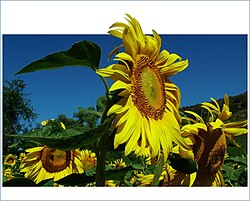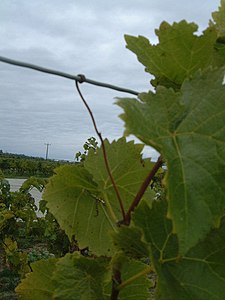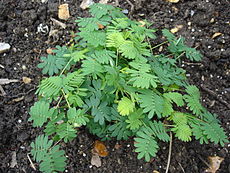Plant perception (physiology)
Plant perception is the ability of
Aspects of perception
Light

Many plant organs contain photoreceptors (phototropins, cryptochromes, and phytochromes), each of which reacts very specifically to certain wavelengths of light.[6] These light sensors tell the plant if it is day or night, how long the day is, how much light is available, and where the light is coming from. Shoots generally grow towards light, while roots grow away from it, responses known as phototropism and skototropism, respectively. They are brought about by light-sensitive pigments like phototropins and phytochromes and the plant hormone auxin.[7]
Many plants exhibit certain behaviors at specific times of the day; for example, flowers that open only in the mornings. Plants keep track of the time of day with a
Studies on the vine Boquila trifoliata has raised questions on the mode by which they are able to perceive and mimic the shape of the leaves of the plant upon which they climb. Experiments have shown that they even mimic the shape of plastic leaves when trained on them.[9] Suggestions have even been made that plants might have a form of vision.[10]
Gravity
To orient themselves correctly, plants must be able to sense the direction of gravity. The subsequent response is known as gravitropism.
In roots, gravity is sensed and translated in the

At the root tip, amyloplasts containing starch granules fall in the direction of gravity. This weight activates secondary receptors, which signal to the plant the direction of the gravitational pull. After this occurs, auxin is redistributed through polar auxin transport and differential growth towards gravity begins. In the shoots, auxin redistribution occurs in a way to produce differential growth away from gravity.
For perception to occur, the plant often must be able to sense, perceive, and translate the direction of gravity. Without gravity, proper orientation will not occur and the plant will not effectively grow. The root will not be able to uptake nutrients or water, and the shoot will not grow towards the sky to maximize photosynthesis.[13]
Touch
All plants are able to sense touch.
Smell
Wounded or infected plants produce distinctive volatile odors, (e.g. methyl jasmonate, methyl salicylate, green leaf volatiles), which can in turn be perceived by neighboring plants.[18][19] Plants detecting these sorts of volatile signals often respond by increasing their chemical defences and/or prepare for attack by producing chemicals which defend against insects or attract insect predators.[18]
Vibration
Plants upregulate chemical defenses such as glucosinolate and anthocyanin in response to vibrations created during herbivory.[20]
Signal transduction
Plant hormones and chemical signals
Plants systematically use
Plants produce several signal molecules usually associated with
Electrophysiology
Plants have a variety of methods of delivering electrical signals. The four commonly recognized propagation methods include action potentials (APs), variation potentials (VPs), local electric potentials (LEPs), and systemic potentials (SPs)[23][24][25]
Although plant cells are not neurons, they can be electrically excitable and can display rapid electrical responses in the form of APs to environmental stimuli. APs allow for the movement of signaling ions and molecules from the pre-potential cell to the post-potential cell(s). These electrophysiological signals are constituted by gradient fluxes of ions such as H+, K+, Cl−, Na+, and Ca2+ but it is also thought that other electrically charge ions such as Fe3+, Al3+, Mg2+, Zn2+, Mn2+, and Hg2+ may also play a role in downstream outputs.[26] The maintenance of each ions electrochemical gradient is vital in the health of the cell in that if the cell would ever reach equilibrium with its environment, it is dead.[27][28] This dead state can be due to a variety of reasons such as ion channel blocking or membrane puncturing.
These electrophysiological ions bind to receptors on the receiving cell causing downstream effects result from one or a combination of molecules present. This means of transferring information and activating physiological responses via a signaling molecule system has been found to be faster and more frequent in the presence of APs.[26]
These action potentials can influence processes such as
The ion flux across cells also influence the movement of other molecules and solutes. This changes the osmotic gradient of the cell, resulting in changes to turgor pressure in plant cells by water and solute flux across cell membranes. These variations are vital for nutrient uptake, growth, many types of movements (tropisms and nastic movements) among other basic plant physiology and behavior.[34][35] (Higinbotham 1973; Scott 2008; Segal 2016).
Thus, plants achieve behavioural responses in environmental, communicative, and ecological contexts.
Signal perception
Plant behavior is mediated by phytochromes, kinins, hormones, antibiotic or other chemical release, changes of water and chemical transport, and other means.
Plants have many strategies to fight off pests. For example, they can produce a slew of different chemical toxins against predators and parasites or they can induce rapid cell death to prevent the spread of infectious agents. Plants can also respond to volatile signals produced by other plants.[36][37] Jasmonate levels also increase rapidly in response to mechanical perturbations such as tendril coiling.[38]
In plants, the mechanism responsible for adaptation is signal transduction.[39][40][41][42] Adaptive responses include:
- Active foraging for light and nutrients. They do this by changing their architecture, e.g. branch growth and direction, physiology, and phenotype.[43][44][45]
- Leaves and branches being positioned and oriented in response to a light source.[43][46]
- Detecting soil volume and adapting growth accordingly, independently of nutrient availability.[47][48][49]
- Defending against herbivores.
Plant intelligence
Plants do not have brains or
Plants respond to environmental stimuli by movement and changes in morphology. They communicate while actively competing for resources. In addition, plants accurately compute their circumstances, use sophisticated cost–benefit analysis, and take tightly controlled actions to mitigate and control diverse environmental stressors. Plants are also capable of discriminating between positive and negative experiences and of learning by registering memories from their past experiences.[53][54][55][56][57] Plants use this information to adapt their behaviour in order to survive present and future challenges of their environments.
Plant physiology studies the role of signalling to integrate data obtained at the genetic, biochemical, cellular, and physiological levels, in order to understand plant development and behaviour. The neurobiological view sees plants as information-processing organisms with rather complex processes of communication occurring throughout the individual plant. It studies how environmental information is gathered, processed, integrated, and shared (sensory plant biology) to enable these adaptive and coordinated responses (plant behaviour); and how sensory perceptions and behavioural events are 'remembered' in order to allow predictions of future activities upon the basis of past experiences. Plants, it is claimed by some[who?] plant physiologists, are as sophisticated in behaviour as animals, but this sophistication has been masked by the time scales of plants' responses to stimuli, which are typically many orders of magnitude slower than those of animals.[citation needed]
It has been argued that although plants are capable of adaptation, it should not be called intelligence per se, as plant neurobiologists rely primarily on metaphors and analogies to argue that complex responses in plants can only be produced by intelligence.[58] "A bacterium can monitor its environment and instigate developmental processes appropriate to the prevailing circumstances, but is that intelligence? Such simple adaptation behaviour might be bacterial intelligence but is clearly not animal intelligence."[59] However, plant intelligence fits a definition of intelligence proposed by David Stenhouse in a book about evolution and animal intelligence, in which he describes it as "adaptively variable behaviour during the lifetime of the individual".[60] Critics of the concept have also argued that a plant cannot have goals once it is past the developmental stage of seedling because, as a modular organism, each module seeks its own survival goals and the resulting organism-level behavior is not centrally controlled.[59] This view, however, necessarily accommodates the possibility that a tree is a collection of individually intelligent modules cooperating, competing, and influencing each other to determine behavior in a bottom-up fashion. The development into a larger organism whose modules must deal with different environmental conditions and challenges is not universal across plant species, however, as smaller organisms might be subject to the same conditions across their bodies, at least, when the below and aboveground parts are considered separately. Moreover, the claim that central control of development is completely absent from plants is readily falsified by apical dominance.[61]
The Italian botanist Federico Delpino wrote on the idea of plant intelligence in 1867.[62] Charles Darwin studied movement in plants and in 1880 published a book, The Power of Movement in Plants. Darwin concludes:
It is hardly an exaggeration to say that the tip of the radicle thus endowed [..] acts like the brain of one of the lower animals; the brain being situated within the anterior end of the body, receiving impressions from the sense-organs, and directing the several movements.
In 2020, Paco Calvo studied the dynamic of plant movements and investigated whether French beans deliberately aim for supporting structures.[63] Calvo said: “We see these signatures of complex behaviour, the one and only difference being is that it’s not neural-based, as it is in humans. This isn’t just adaptive behaviour, it’s anticipatory, goal-directed, flexible behaviour.”[64]
In philosophy, there are few studies of the implications of plant perception. Michael Marder put forth a phenomenology of plant life based on the physiology of plant perception.[65] Paco Calvo Garzon offers a philosophical take on plant perception based on the cognitive sciences and the computational modeling of consciousness.[66]
Comparison with neurobiology
Plant sensory and response systems have been compared to the
The ideas behind plant neurobiology were criticised in a 2007 article[58] published in Trends in Plant Science by Amedeo Alpi and 35 other scientists, including such eminent plant biologists as Gerd Jürgens, Ben Scheres, and Chris Sommerville. The breadth of fields of plant science represented by these researchers reflects the fact that the vast majority of the plant science research community rejects plant neurobiology as a legitimate notion.[citation needed] Their main arguments are that:[58]
- "Plant neurobiology does not add to our understanding of plant physiology, plant cell biology or signaling".
- "There is no evidence for structures such as neurons, synapses or a brain in plants".
- The common occurrence of plasmodesmata in plants "poses a problem for signaling from an electrophysiological point of view", since extensive electrical coupling would preclude the need for any cell-to-cell transport of ‘neurotransmitter-like' compounds.
The authors call for an end to "superficial analogies and questionable extrapolations" if the concept of "plant neurobiology" is to benefit the research community.[58] Several responses to this criticism have attempted to clarify that the term "plant neurobiology" is a metaphor and that metaphors have proved useful on previous occasions.[67][68] Plant ecophysiology describes this phenomenon.
Parallels in other taxa
The concepts of plant perception, communication, and intelligence have parallels in other biological organisms for which such phenomena appear foreign to or incompatible with traditional understandings of biology, or have otherwise proven difficult to study or interpret. Similar mechanisms exist in
See also
- Auxin
- Biosemiotics
- Chemotropism
- Ethylene
- Gravitropism
- Heliotropism
- Hydrotropism
- Hypersensitive response
- Kairomone
- Kinesis (biology)
- Nastic movements
- Phytosemiotics
- Plant cognition
- Plant defense against herbivory
- Plant evolutionary developmental biology
- Plant perception (paranormal)
- Plant tolerance to herbivory
- Rapid plant movement
- The Secret Life of Plants
- Statocyte
- Stoma
- Systemic acquired resistance
- Taxis
- Thermotropism
- Tropism
References
- PMID 16054860.
- PMID 22445066.
- PMID 23754865.
- S2CID 5231736.
- PMID 27342223.
- ^ PMID 11687489.
- S2CID 84386403.
- ^ Strid Å, Porra RJ (1992). "Alterations in Pigment Content in Leaves of Pisum sativum After Exposure to Supplementary UV-B". Plant and Cell Physiology. 33 (7): 1015–1023. Archived from the original on 26 April 2010.
- PMID 34545774.
- .
- OCLC 821271420.
- PMID 19453506.
- PMID 16033778.
- PMID 15720650.
- S2CID 29466083.
- ^ Fearnley, Kirsten (3 May 2016). "Weird & Wonderful Creatures: The Sensitive Plant". American Association for the Advancement of Science. American AAAS. Retrieved 23 February 2021.
when it is touched, its leaves fold up and its branches droop, leaving it looking dead or sick in a matter of seconds
- PMID 19516982– via Taylor & Francis Group.
- ^ PMID 11607107.
- ^ Mirabella, R., H. Rauwerda, S. Allmann, A. Scala, E. A. Spyropoulou, M. de Vries, M. R. Boersma, T. M. Breit, M. A. Haring, and R. C. Schuurink. 2015. WRKY40 and WRKY6 act downstream of the green leaf volatile E-2-hexenal in Arabidopsis. The Plant Journal 83:1082–1096.
- PMID 24985883.
- ^ Akula, R., and S. Mukherjee. 2020. New insights on neurotransmitters signaling mechanisms in plants. Plant Signaling & Behavior 15:1737450. Taylor & Francis.
- ISBN 978-3-540-28475-8.
- PMID 17263772.
- PMID 26944636.
- PMID 28959209.
- ^ S2CID 53210689.
- PMID 23221742.
- PMID 27829975.
- ^ Wagner E, Lehner L, Normann J, Veit J, Albrechtova J (2006). "Hydroelectrochemical integration of the higher plant—basis for electrogenic flower induction". In Baluska F, Mancuso S, Volkmann D (eds.). Communication in plants: neuronal aspects of plant life. Berlin: Springer. pp. 369–389.
- PMID 17263772.
- PMID 19129416.
- S2CID 5026557.
- PMID 26872949.
- PMID 27249799.
- ISBN 978-0-470-85024-4.
- PMID 11607107.
- S2CID 33992175.
- S2CID 23326940.
- ISBN 0-19-963879-9.
- PMID 11454221.
- PMID 12194182.
- PMID 10200239.
- ^ JSTOR 2261158.
- S2CID 20183179.
- ISBN 9780120139255.
- S2CID 44773996.
- JSTOR 1938905.
- JSTOR 2389968.
- ISBN 9780120139286.
- PMID 9888852.
- PMID 31006360.
- PMID 16843034.
- PMID 14535888.
- PMID 19356999.
- S2CID 29195832.
- S2CID 5038227.
- PMID 27910933.
- ^ PMID 17368081.
- ^ PMID 15023701.
- ^ Phillips H (27 July 2002). "Not just a pretty face". New Scientist.
- ISSN 0031-9317.
- PMID 21490417.
- PMID 33173160.
- ^ Geddes, Linda (8 January 2021). "Food for thought? French bean plants show signs of intent, say scientists". The Guardian. Retrieved 8 January 2021.
- PMID 22951403.
- PMID 19516990.
- PMID 17499006.
- PMID 17591455.
Further reading
- Baluška F (ed) (2009). Plant-Environment Interactions: From Sensory Plant Biology to Active Plant Behavior. Springer Verlag.
- Brenner ED, Stahlberg R, Mancuso S, Vivanco J, Baluska F, Van Volkenburgh E (August 2006). "Plant neurobiology: an integrated view of plant signaling". Trends in Plant Science. 11 (8): 413–9. PMID 16843034.
- Cvrcková F, Lipavská H, Zárský V (May 2009). "Plant intelligence: why, why not or where?". Plant Signaling & Behavior. 4 (5): 394–9. PMID 19816094.
- Garzón FC (July 2007). "The quest for cognition in plant neurobiology". Plant Signaling & Behavior. 2 (4): 208–11. PMID 19516990.
- Gilroy S, Masson PH (2007). Plant Tropisms. Iowa State University Press.
- Karban R (July 2008). "Plant behaviour and communication". Ecology Letters. 11 (7): 727–39. PMID 18400016.
- Karban R (2015). Plant Sensing and Communication. University of Chicago Press.
- Mancuso S, Shabala S (2006). Rhythms in Plants. Springer Verlag.
- Manetas, Yiannis (2012). "Are Plants Intelligent Organisms After All?". Alice in the Land of Plants. Berlin, Heidelberg: Springer Berlin Heidelberg. pp. 323–342. ISBN 978-3-642-28337-6.
- Scott P (2008). Physiology and Behaviour of Plants. John Wiley & Sons Ltd.
- Trewavas A (July 2003). "Aspects of plant intelligence". Annals of Botany. 92 (1): 1–20. PMID 12740212.
- Trewavas A (September 2005). "Plant intelligence". Die Naturwissenschaften. 92 (9): 401–13. S2CID 26665579.
- Trewavas A (June 2009). "What is plant behaviour?". Plant, Cell & Environment. 32 (6): 606–16. PMID 19143994.
- Volkov AG (2006). Plant Electrophysiology. Springer Verlag.
- Volkov AG, Carrell H, Adesina T, Markin VS, Jovanov E (July 2008). "Plant electrical memory". Plant Signaling & Behavior. 3 (7): 490–2. PMID 19704496.
- Keen NT, Mayama S, Leach JE, Tsujumu S, eds. (2001). Delivery and Perception of Pathogen Signals in Plants. ISBN 0-89054-259-7.
- Taiz L, Zeiger E (2006). Plant Physiology, fourth edition. ISBN 0-87893-856-7.
- Miller D, Hable W, Gottwald J, Ellard-Ivey M, Demura T, Lomax T, Carpita N (December 1997). "Connections: the hard wiring of the plant cell for perception, signaling, and response". The Plant Cell. 9 (12): 2105–17. PMID 9437857.
- Scheel D, Wastermack C (May 2002). Plant Signal Transduction. ISBN 978-0-19-963879-6. Retrieved 25 December 2006.
- Taiz L, Zeiger E (2002). Plant Physiology Online: A companion to Plant Physiology (Third ed.). Sinauer Associates. Archived from the original on 7 December 2006. Retrieved 26 December 2006.
External links
- Plant Signaling and Behavior[dead link] Scientific journal for Plant Neurobiology
- Plants cannot "think and remember," but there's nothing stupid about them: They're shockingly sophisticated[dead link]
- How Does a Venus Flytrap Work?



